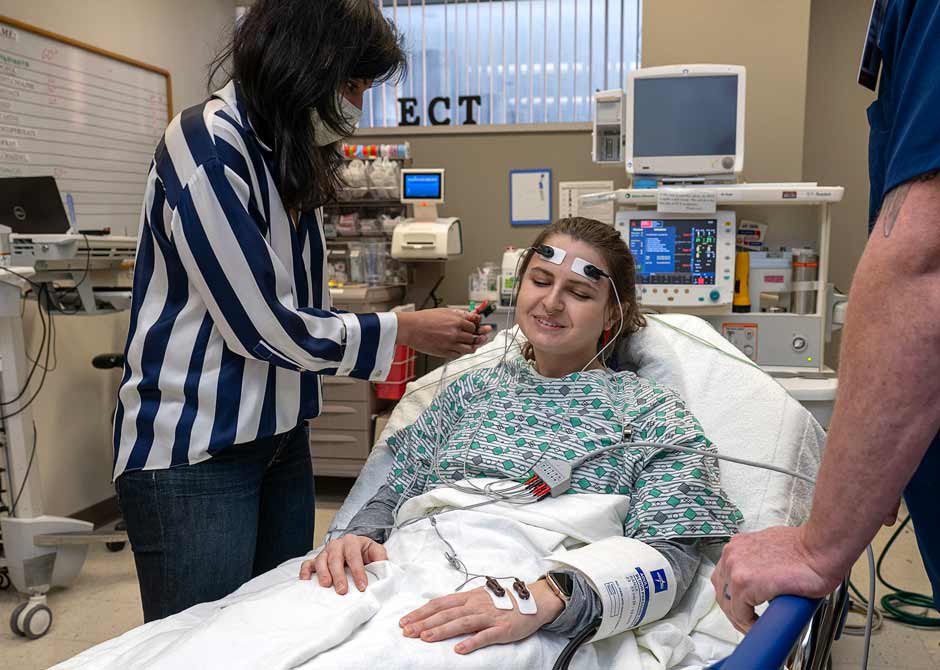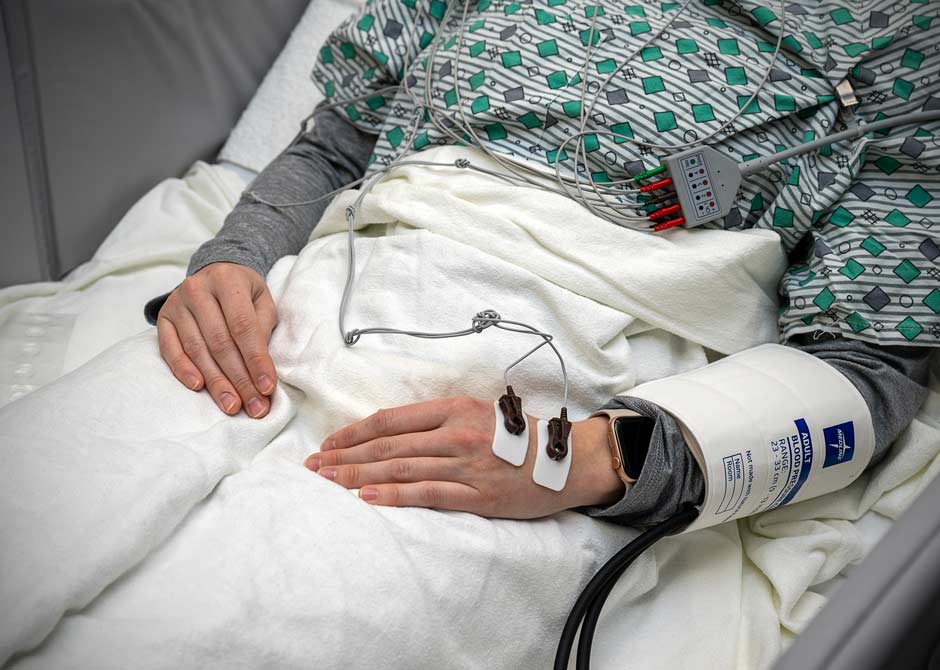 Electroconvulsive therapy (ECT) is a treatment used for depression and other mental health conditions.
Electroconvulsive therapy (ECT) is a treatment used for depression and other mental health conditions.
When other, more common forms of mental health treatment — such as medications or psychotherapy — have not worked well enough to treat your condition, the mental and behavioral health experts at The Ohio State University Wexner Medical Center have numerous other therapies they can use to improve your symptoms and quality of life.
If you or a loved one is suffering from severe depression or other worsening mental health conditions, you might want to consider undergoing ECT. Our mental health experts excel at identifying candidates who will benefit the most from ECT and administering the therapy safely and effectively.
What is electroconvulsive therapy (ECT)?
ECT is a treatment for severe depression and other mood disorders. During the procedure, a mild electrical current is passed through a person’s brain to trigger a seizure. This action seems to change the brain’s chemistry or reset the brain, causing relief in certain mental health conditions.
This form of treatment has a long history in mental health; however, it’s much safer, more controlled and less painful now. You’re under general anesthesia, meaning you’re put to sleep, for the stimulation and seizure, and you won’t feel anything.
Though the procedure is done in an office setting (outpatient) and safe, it’s generally used after medications, psychotherapy and other treatments haven’t worked.
How does ECT work?
While you’re under general anesthesia, we’ll use a machine to pass a small amount of electric current through your brain to trigger a seizure. The seizure is brief, lasting 60 seconds or less, and we give you medicine to prevent the seizure from spreading throughout the body. You’ll wake up several minutes later, not remembering the treatment.
According to the National Institute of Mental Health, 80-90% of people with severe depression improve dramatically with ECT. We’re not entirely sure why this works, but there are several theories behind why ECT can be so effective.
What conditions does ECT treat?
ECT treats certain types of mood disorders and other mental health conditions. Conditions include:
- Severe depression
- Bipolar depression
- Psychosis
- Schizophrenia
- Severe mania
- Catatonia
- Agitation in people with dementia
You also will have to meet certain criteria before ECT is recommended as a treatment. If one or more of the following is true, you might be a candidate for ECT:
- Your condition hasn’t responded to medication or psychotherapy, also known as resistant to treatment.
- Your condition has become life-threatening.
- You’re pregnant and medications could be harmful to your baby.
- You can’t tolerate the side effects of the medications.
- You prefer ECT over medications, and it’s been successful in the past.
What to expect during ECT?
The actual procedure of administering electroconvulsive therapy takes only about five to 10 minutes; however, you’ll also spend time preparing to be put under general anesthesia and in recovery after you wake up. The procedure is done as an outpatient treatment, meaning you go home the same day, or sometimes it’s administered to people who are already hospitalized and undergoing other treatments.
Before the procedure
There are several steps to take before deciding if you’re a good candidate for ECT and ensuring it will be safe for you. Those include:
- A complete medical history
- A physical exam
- Psychiatric evaluation
- Blood tests
- An electrocardiogram (EEG) to look at brain activity
If you and your doctor think this treatment will benefit you, you’ll schedule an outpatient appointment to receive it. Since you’ll be under general anesthesia, you’ll need to refrain from eating or drinking the night before ECT. Before the actual procedure begins, our health staff will take vitals, insert an intravenous line and place electrode pads on your head.
During the procedure
After general anesthetics are given to make you fall asleep, the procedure moves quickly. Steps include:
- The ECT machine is attached to the electrode pads and turned on.
- A mild electrical current passes though these electrode pads to the brain.
- Because of this stimulation, you’ll experience a short seizure. You won’t feel any pain or remember the seizure.
- We’ll monitor brain activity through an EEG while also monitoring your vitals during the seizure.
- You’ll wake up in the recovery room a bit groggy but should return to normal quickly.
- We’ll monitor you for any issues for about 30 minutes, as is the case any time you receive general anesthetics, and then you can go home.
Results of ECT
Sometimes only a handful of sessions given over a few weeks are needed to see an improvement in symptoms or to allow medications to be effective in treating your mood disorder. Other times, it takes recurring ECT to keep your symptoms at bay.
Risks of ECT
Electroconvulsive therapy is safe, and we’ve vastly improved this safety over decades of research. However, just like with any procedure that uses general anesthetics, there are risks.
Possible side effects of ECT include:
- Confusion or memory loss – Immediately following the procedure, you might experience some confusion or memory loss. This generally subsides a few minutes or hours after ECT. Sometimes these side effects can last longer, especially in older adults.
- Physical side effects – Some people may experience nausea, headaches, jaw pain or muscle soreness the day of the procedure. These can be managed with over-the-counter pain relievers.
- Complications from anesthesia – There’s always a risk when general anesthetics are used.
Can ECT cause permanent brain damage?
Decades of research and advancement have made this procedure very safe for most people. Using imaging studies of the brain and other diagnostic tools, available research shows that long-lasting negative effects, like memory loss, are rare. It’s important to talk to your doctor about any health concerns and review any alternatives.
People not recommended for ECT
Certain people should not undergo electroconvulsive therapy. Those people include:
- Someone who has had a recent heart attack or other heart issue.
- Someone who has had a recent stroke, aneurysm or other brain bleeding.
- Someone with severe lung conditions, such as chronic obstructive pulmonary disease (COPD).
- Someone with a condition that increases pressure in the brain, such as intracranial hypertension or a tumor.
- Anyone who isn’t healthy enough to go under general anesthesia.

